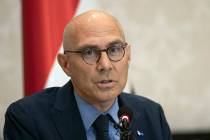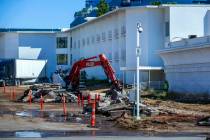Hospitals’ losses rise
Clark County acute-care hospitals had their worst year on record in 2008, and the state's shaky economy and rising unemployment are expected to create more problems for uninsured people and the health community in the near future.
Because of the recession and local hospitals' long-standing reimbursement problems area hospitals posted a cumulative operating loss of $68.3 million last year, $408 for every patient that checked in, by far the worst performance on record. As recently as 2006, numbers reported to the state's Department of Health and Human Services by the individual hospitals showed an operating profit of $16.7 million.
Although the continuing struggles at the county-owned University Medical Center of Southern Nevada, which posted a $73.2 million loss, weighed heavily on the results, five of the other 13 hospitals (Boulder City Hospital was excluded) also operated in the red. The first quarter brought no hints of help anytime soon: Seven of the 13 hospitals showed losses.
For a number of years, the strong position managed-care insurance plans hold in the valley have worked to depress rates paid to hospitals compared with other markets. At the same time, Medicaid payments by the state on behalf of low-income patients ranked among the lowest in the country by some standards.
"Those two factors combined create a problematic health care environment in Las Vegas," said Rod Davis, president of St. Rose Dominican Hospitals, which owns three hospitals. "To overlay the economy only exacerbates the challenges."
As the unemployment rate has marched toward historic highs, more people have lost their health insurance. As a result, hospitals report more emergency room visits by uninsured patients who show up because they no longer can pay for office visits, forcing larger uncollectible bills. By law, hospitals have to treat people who come in their doors, whether they are insured or not.
The state has extended for two years a 5 percent Medicaid cut that was supposed to expire on Tuesday. And the number of patients for most hospitals has grown slowly or even started to decline.
Tighter Medicaid and Medicare payments could lead to trying to wring more money from private insurers, what is known as cost shifting. But how well that will work is questionable as the insurance companies try to hold down their expenses.
"There is a certain ability to cost shift, but I think that window is rapidly closing," said Kathy Silver, the CEO at University Medical Center. "We are trying to look in every corner for ways to reduce expenses."
Total revenues for the county, after the numerous deductions from nominal bills, rose 2.9 percent to $2.7 billion. But the deduction rate rose from $77.10 for every $100 to $78.80, meaning that last year hospitals were entitled to collect only 21.2 percent of their billings. For many of the hospitals, a couple of percentage points can make the difference between profit and loss.
The prospect that the financial situation will continue to deteriorate has raised the prospect of cutbacks in an area where the major task for decades has been trying to keep pace with the area's growth.
"The worst-case scenario is to eliminate services," said Bill Welch, president of the Nevada Hospital Association. "There have been hospitals I can't name that have had these discussions, but they are doing everything they can to avoid it and hope the economy turns around."
Jack London, president of the London Medical Management consulting firm, thinks the worst case could become the viable case should the trends continue.
"There could come a point when hospitals will have to stop the bleeding," he said. "The way to do that is to start closing doors."
But hospital administrators, at this point, expect less drastic measures to carry them through.
The three hospitals owned by Hospital Corporation of America through its Sunrise Health facility all posted operating losses, but Chief Financial Officer Dan Perritt said that at least part of that arises from non-cash depreciation and amortization charges from previous capital investments.
"We have to focus on our cost structure. That's what we can control," said Perritt, who places a low probability on service cuts. "We have seen things slightly improving, but it really depends on when the economy of Las Vegas starts to turn around."
St. Rose has put off major expansion and renovation plans at Siena and Rose de Lima. Davis said travel budgets have been slashed, discretionary spending cut, and all positions, including replacements, must by reviewed by the facility president before they are filled.
But an interim enlargement at the Siena operating room will go ahead to relieve some of the facility's crowding. At 90 percent, it led Las Vegas in occupancy.
The Valley Health Systems division of Universal Health Systems managed to produce operating profits at all five of its hospitals, including Centennial Hills, which opened in January 2008. Company executives declined to comment on the results, but they were in line with the increased profits reported companywide.
London described them as a "lean, mean fighting machine, They keep their costs under control. They are aggressive in their marketing and contracting practices."
And they have benefited from hospitals, such as Summerlin, located in areas with demographics that bring in relatively high numbers of privately insured patients. By contrast, Sunrise and Rose de Lima, in the southeast corner of the valley, are in areas where declining incomes have hurt reimbursements and brought disproportionately high levels of charity care.
In the southwest, projections a few years ago of a building boom led to the construction of both St. Rose San Martin and Southern Hills within a couple of miles of each other. Now that the real estate bust has slammed the brakes on population growth, San Martin lost $15.4 million and Southern Hills $36.2 million. Although that was an improvement for San Martin from 2007, the Southern Hills loss widened.
But regional concerns aside, the local hospitals fall into the patterns of the industry nationwide. According to a March survey by the American Hospital Association covering nearly 1,100 hospitals, almost half have cut floor staff, and 80 percent have trimmed administration. But 80 percent have steered away from service cuts. At the same time, 58 percent saw more uninsured patients walking into the ER, and 70 percent had to swallow higher levels of unpaid care.
Also, 59 percent of the hospitals registered a drop in elective procedures. That hits the bottom line directly because nonemergencies are generally scheduled by patients who have private health insurance.
More than half have seen their profit margins slide, and 90 percent have pared budgets.
Contact reporter Tim O'Reiley at toreiley @lvbusinesspress.com or 702-387-5290.





























